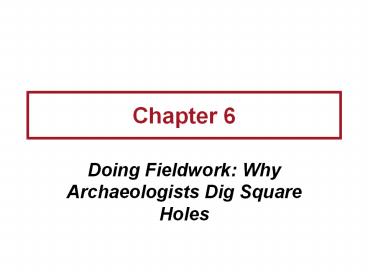Doing Fieldwork: Why Archaeologists Dig Square Holes - PowerPoint PPT Presentation
1 / 20
Title:
Doing Fieldwork: Why Archaeologists Dig Square Holes
Description:
Water-screening A sieving process in which deposit is placed in a screen and the matrix washed away with hoses. – PowerPoint PPT presentation
Number of Views:116
Avg rating:3.0/5.0
Title: Doing Fieldwork: Why Archaeologists Dig Square Holes
1
Chapter 6
- Doing Fieldwork Why Archaeologists Dig Square
Holes
2
Outline
- ExcavationWhat Determines Preservation?
- Principles of Archaeological Excavation
- Precision Excavation
- Sifting the Evidence
- Cataloging the Finds
- Conclusion Archaeologys Conservation Ethic Dig
Only What You Must
3
Provenience
- An artifacts provenience is its location and
context within a site. - This is the most important thing about that
artifact. - The guiding rule in all excavation is to record
context, and this means recording provenience of
artifacts, features, and ecofacts.
4
Excavation What Determines Preservation?
- The exact procedures in any excavation depend on
several factors, beginning with the kind of
materials that have survived the passage of time. - Decomposition is carried out by microorganisms
that require warmth, oxygen, and water to
survive.
5
The Excavators Toolkit
- 56 inch trowel
- Metal file
- 2- and 25-meter tape measure
- Work gloves
- Builders level and angle finder
- Compass
- Pencils and Sharpie pens
- Spoon, Nails
- Straight-edge ruler
- Torpedo level
- Root clippers
- Small wire cutters
- Empty film canisters
- Toilet paper (for wrapping delicate artifacts)
- Toothpicks (for temporarily marking artifact
locations)
6
How Archaeologists Dig
- Archaeologists excavate within horizontal
excavation units in natural levels and arbitrary
levels. - Natural levels are the sites strata which are
more or less homogeneous, visually separable from
other levels by a change in texture, color, rock
or organic content. - Archaeologists prefer to excavate in natural
levels wherever possible.
7
How Archaeologists Dig
- Arbitrary levels are basic vertical subdivisions
of an excavation square. - They are used only when recognizable natural
strata are lacking and when natural strata are
more than 10cm.
8
Arbitrary Levels Can Effect Artifacts From
Natural Strata
- The natural strataA, B, C, and Deach contain a
particular kind of artifact. - Each strata represents a unit of time.
- If excavated using arbitrary levels1, 2, 3, and
4those levels would crosscut the strata.
9
Sifting the Evidence
- Digging is just the beginning of excavation.
- No matter how carefully you excavate, it is
impossible to see, map, and recover everything of
archaeological interest. - Sifters find things that hand excavation misses.
10
(No Transcript)
11
Why Archaeologists Dig Square Holes
- If pit sidewalls are kept straight and
perpendicular, excavators can use the dirt to
maintain horizontal control on the X and Y axes
by measuring directly from the sidewalls. - If the excavator misses something, the sifting
process can tie its provenience down to a
particular level in a particular unita very
small area of the site.
12
Water-screening
- A sieving process in which deposit is placed in a
screen and the matrix washed away with hoses. - Essential where artifacts are expected to be
small and/or difficult to find without washing.
13
Flotation
- Using fluid suspension to recover burned plant
remains and bone fragments. - Based on the principle Dirt doesnt float, but
carbonized plant remains do. - Seemingly unimportant burnt seeds collected
through flotation helped make the important
discovery that Native Americans domesticated
plants more than 4000 years ago.
14
Quick Quiz
15
- 1. The guiding rule in all excavation is to
record context, and this means recording ________
of artifacts, features, and ecofacts.
16
Answer provenience
- The guiding rule in all excavation is to record
context, and this means recording provenience of
artifacts, features, and ecofacts.
17
- 2. Archaeologists prefer to excavate in arbitrary
levels wherever possible. - True
- False
18
Answer B. False
- Archaeologists prefer to excavate in natural
levels wherever possible
19
- 3. No matter how carefully you excavate, it is
impossible to see, map, and recover everything of
archaeological interest, _____ finds things that
excavation misses.
20
Answer sifting
- No matter how carefully you excavate, it is
impossible to see, map, and recover everything of
archaeological interest, sifting finds things
that excavation misses.































